In this post, we will talk about Top Salesforce Integration Interview questions and answers. These top Salesforce integration interview questions with answers will help you to get your dream job as a Salesforce integration professional. This list contains everything from the basic to the advanced questions.
Top Salesforce Integration Interview Questions
Here is a list of Top Salesforce Integration Interview Questions in 2022. Before this check our Complete Salesforce Integration guide.
- What is Integration?
- What is webservices?
- Difference between JSON Vs XML ?
- What is REST API ?
- What is SOAP API ?
- What is difference between SOAP and REST?
- What all Integration option are available in Salesforce?
- What is WSDL?
- What is SoapUI?
- What is difference between Enterprise WSDL and Partner WSDL?
- What is an Integration Patterns?
- Different type of Integration patterns available in Salesforce?
- What is remote site settings?
- What is a Connected App?
- What is OAuth?
- What are different OAuth2.0 Authorization flows are available in Salesforce?
- What is JWT flow in Salesforce?
- What is web service flow in Salesforce?
- What is Named Credentials and what is the use of it?
- What is OpenID Connect?
- Difference between OpenID and OAuth?
- What is Streaming API? Explain the different mechanism of Steaming API?
- What is Change Data Capture?
- What is Tooling API? Provide one example when you used it.
- What is Salesforce Connect?
- What are REST API Composite Resources
- Difference Between API Gateway VS ESB?
- What is API Gateway?
- What is the use of Middleware(App Glue) In Enterprise Context?
Before getting started check our Salesforce Integration with External System post.
Basic Integration Questions
1. What is Integration?
Integration is a process of connecting two or more applications. Enterprise system uses many applications, many or most of which are not designed to work with one another out of the box. Each application can have data, business logic, presentation, and security layers, all of which are possible targets for integration.
2. What is webservices?
Web service is a standardized medium to propagate communication between the client and server applications on the World Wide Web. Web services provide a common platform that allows multiple applications built on various programming languages to have the ability to communicate with each other.
Webservices are functionality or code which helps us to do integration. Web services are open standard (XML, SOAP, HTTP, etc.) based web applications that interact with other web applications for the purpose of exchanging data.
Type of Web Service
There are mainly two types of web services.
- SOAP web services.
- RESTful web services
3. Difference between JSON Vs XML?
Here is some difference between JSON and XML. Check this post for more detail.
| JSON | XML |
| JavaScript Object Notation has a type like String, number, Object, Boolean | Extensible markup language is type less, and should be string |
| It is a way of representing objects | It is a markup language and uses tag structure to represent data items |
| Retrieving value is easy | Retrieving value is difficult |
| It does not provide any support for namespaces. | It supports namespaces. |
| It is less secured | It is more secure than JSON |
| Guidelines: Key – Enclosed in double Quotes(String) Value – Can be any datatype {} – Object [] – Array , – Separates data element within Object | Guidelines: Element – <lastname>hours</lastname> Element Definition: <xs:element name=”lastname” type=”xs:string”/> Attribute – <lastname lang=”EN”>Smith</lastname> Attribute Definition – <xs:attribute name=”lang” type=”xs:string”/> |
4. What is REST API?
A REST API is also known as RESTful API. REST API is an application programming interface (API) that conforms to the constraints of REST architectural style and allows for interaction with RESTful web services.
RESTful API is an interface that two computer systems use to exchange information securely over the internet. REST API has a lightweight request and response framework. It is a simple, easy-to-use, and powerful web service based on RESTful principles. REST API supports both XML and JSON. Rest resource is referenced using URI, abstraction of information, and access using HTTP methods.
5. What is SOAP API?
SOAP is the Simple Object Access Protocol, a messaging standard defined by the World Wide Web Consortium and its member editors. SOAP uses an XML data format to declare its request and response messages, relying on XML Schema and other technologies to enforce the structure of its payloads.
- It uses a Web Services Description Language (WSDL) file to rigorously define the parameters for accessing data through the API.
- SOAP API supports XML only.
- Because SOAP API uses the WSDL file as a formal contract between the API and consumer, it’s great for writing server-to-server integrations.
6. What is the difference between SOAP and REST?
Here is the difference between SOAP and REST API.
| SOAP API | REST API |
| Relies on SOAP protocol | Relies on REST architecture using HTTP |
| Transports data in XML | Transports data in JSON or XML |
| Highly structured/ typed | Less structured? Less bulky data |
| Handles large data loads | Works well with JavaScript |
| Designed with large enterprise application in mind | Designed with mobile devices in mind |
Salesforce Integration Interview Questions
7. What all Integration options are available in Salesforce?
There are lots of Integration option are available in Salesforce. Some of the are below.
| API Name | Protocol | Data Format | Communication |
| REST API | REST | JSON, XML | Synchronous |
| SOAP API | SOAP (WSDL) | XML | Synchronous |
| Chatter REST API | REST | JSON, XML | Synchronous (photos are processed asynchronously) |
| Analytics REST API | REST | JSON, XML | Synchronous |
| Bulk API | REST | CSV, JSON, XML | It’s Asynchronous. Handle large data loads with batching. |
| Metadata API | SOAP (WSDL) | XML | Asynchronous. Retrieve, deploy, and modify metadata. |
| Streaming API | Bayeux | JSON | Asynchronous. Push notifications from Salesforce to subscribing applications/entities (replaces polling). |
| Apex REST API | REST | JSON, XML, Custom | Synchronous |
| Apex SOAP API | SOAP (WSDL) | XML | Synchronous |
| Tooling API | Build custom development tools for Salesforce platform applications |
8. What is WSDL?
WSDL (Web Services Description Language) is an XML document that describes a web service. There are two types of WSDL in Salesforce:
- Enterprise WSDL
- Partner WSDL
9. What is the difference between Enterprise WSDL and Partner WSDL?
Here is the difference between Enterprise WDSL and Partner WDSL.
| Enterprise WDSL | Partner WSDL |
| Strongly Typed | Loosely Typed |
| Tied to a specific configuration of Salesforce | Useful for any configuration of Salesforce |
| Changes if custom field or custom objects are added to your organization | Does not changes if custom field or custom objects are added to an organization’ Salesforce configuration |
| Primarily for Customer | Primarily for Partner |
10. What is SoapUI? How to Use SoapUI to Test Salesforce WebService?
SOAP UI is a very popular API testing tool especially when we talk about SOAP APIs. So, in this tutorial, we’re going to see how we can connect with Salesforce Org using SOAP UI and we will call a standard salesforce soap API and have a look at the response. Check below recording how to test Salesforce webservice using SoapUI.
11. What are integration patterns in salesforce?
When you implement Salesforce, you frequently need to integrate it with other applications. Although each integration scenario is unique, there are common requirements and issues that developers must resolve.
12. Different types of Integration patterns available in Salesforce?
Check our blog post Salesforce integration Patterns & Best Practices to learn more.
| Pattern | Scenario |
| Remote Process Invocation—Request and Reply | Salesforce invokes a process on a remote system, waits for completion of that process, and then tracks state based on the response from the remote system. |
| Remote Process Invocation—Fire and Forget | Salesforce invokes a process in a remote system but doesn’t wait for completion of the process. Instead, the remote process receives and acknowledges the request and then hands off control back to Salesforce. |
| Batch Data Synchronization | Data stored in Lightning Platform is created or refreshed to reflect updates from an external system, and when changes from Lightning Platform are sent to an external system. Updates in either direction are done in a batch manner. |
| Remote Call-In | Data stored in Lightning Platform is created, retrieved, updated, or deleted by a remote system. |
| UI Update Based on Data Changes | The Salesforce user interface must be automatically updated as a result of changes to Salesforce data. |
| Data Virtualization | Salesforce accesses external data in real time. This removes the need to persist data in Salesforce and then reconcile the data between Salesforce and the external system. |
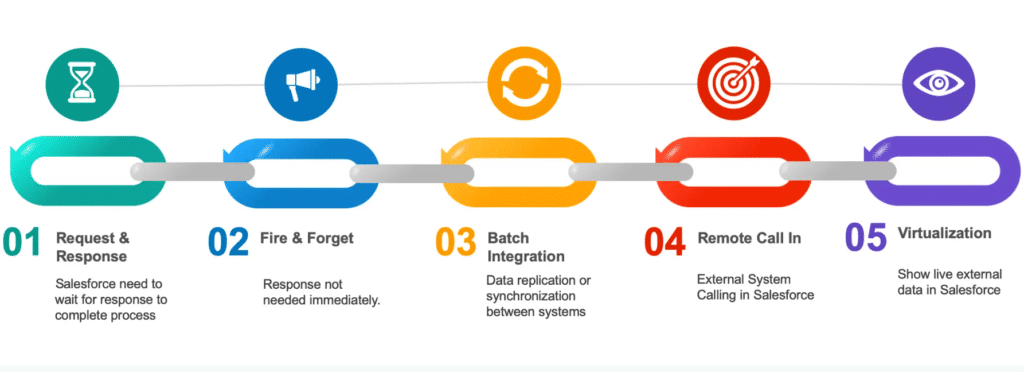
13. What is remote site settings?
Remote site settings is used to authorize the endpoint and allow us to whom integrate(end user)
Connected App And OAuth
14. What is a Connected App?
A connected app is a framework that enables an external application to integrate with Salesforce using APIs and standard protocols, such as SAML, OAuth, and OpenID Connect. Connected apps use these protocols to authenticate, authorize, and provide single sign-on (SSO) for external apps. The external apps that are integrated with Salesforce can run on the customer success platform, other platforms, devices, or SaaS subscriptions.
15. What is OAuth?
OAuth is short for open authorization. OAuth 2.0 is a framework that allows for a secure way for systems to establish trust with one another. The end goal is to obtain an access token that can be used by to access protected resources without ever providing your username or password to the other system.
16. What different OAuth2.0 Authorization flows are available in Salesforce?
You decide! Salesforce supports the following flows
- SAML Bearer Assertion
- JWT Bearer Token
- Refresh Token
- Web Server Authentication
- Username-Password
- User-Agent
- Device Authentication
- Asset Token
- SAML Assertion
17. What is JWT flow in Salesforce?
Secure server-to-server integration without real time user involvement. Client specifies user in a JSON web token (JWT) or SAML format XML assertion and proves its own identity by appending a signature. JWT Bearer token flow is Ideal for application which access sfdc only through API as there is no UI involved. For example ETL tools or middleware.
JWT Structure
When we talk about JSON Web Token, it is consist of 3 parts
- Headers – Which contains the algorithm which will be used to sign the request
{"alg":"RS256"} - Payload – This contains claims information which is an object containing information about user and additional data. Claims are set using parameters-
{"Iss,aud,sub,exp"} - Signature – Signature consists of 3 parts and the structure is given below
<headerbase64encodedurl>.<claimsbase64encodedclaims>.<signature(uses algorithm like RS 256)>18. What is web service flow in Salesforce?
Allows apps with a secure client server (one which can protect a secret or private key) to access protected resources. This flow is mainly used by applications hosted on web server. If external application is trusted one and hosted on secure server and can securely store client_secret, then flow can be used. This flow is used mainly to build web application.
Learn more from Authorisation Code With Secret (Web Server flow).
19. What is Named Credential and what is its use of it?
A named credential specifies the URL of a callout endpoint and its required authentication parameters in one definition. To simplify the setup of authenticated callouts, specify a named credential as the callout endpoint.
20. What is OpenID Connect?
OpenID Connect is a simple identity layer on top of the OAuth 2.0 protocol. It allows Clients to verify the identity of the End-User based on the authentication performed by an Authorization Server, as well as to obtain basic profile information about the End-User. Learn more here.
OpenID Connect Flow
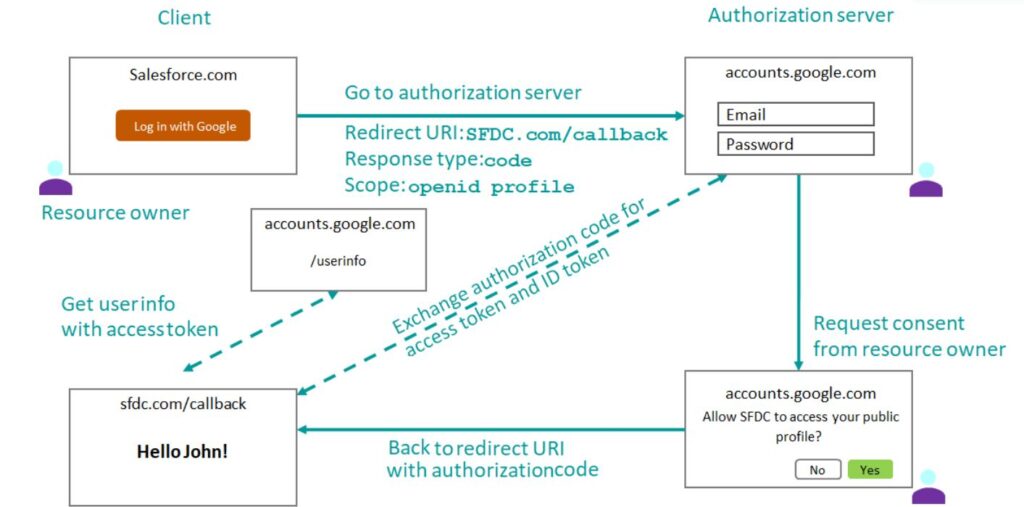
21. Difference between OpenID and OAuth?
| OAuth 2.0 | OpenID Connect |
| Granting access to your API | Logging the user in |
| Getting access to user data in other systems | Making your accounts available in other systems |
| This is primarily used for Authorization | This is primarily used for Authentication |
Streaming API and Events
22. What is Streaming API? Explain the different mechanisms of Steaming API.
Streaming API enables the streaming of events using push technology and provides a subscription mechanism for receiving events in near real-time. The Streaming API subscription mechanism supports multiple types of events, including PushTopic events, generic events, platform events, and Change Data Capture events
Learn about terms used for Streaming API
| Term | Description |
| Event | The creation, update, delete, or undelete of a record. Each event might trigger a notification. |
| Notification | A message in response to an event. The notification is sent to a channel to which one or more clients are subscribed. |
| PushTopic | A PushTopic triggers notifications for changes in Salesforce records resulting from a create, update, delete, or undelete operation. A PushTopic notification is based on the criteria that you specify in the PushTopic record and the SOQL query that you define. Only the fields specified in the query are included in the notification. The PushTopic defines a subscription channel. |
| Channel | A stream of events to which a client can subscribe to receive event notifications. |
| Event Bus | A conduit in which a publisher sends an event notification. Event subscribers subscribe to a channel in the event bus to receive event notifications. The event bus supports replaying stored event messages |
| Platform Event | A Salesforce entity that represents the definition of the custom data that you send in a platform event message. You create a platform event and define its fields in Salesforce. The subscription channel is based on the platform event name. |
| Change Data Capture Event | Similar to a PushTopic, Change Data Capture triggers notifications for changes in Salesforce records resulting from a create, update, delete, or undelete operation. Unlike a PushTopic, Change Data Capture sends all changed fields of a record and doesn’t require you to specify the fields in a query. Also, Change Data Capture sends information about the change in headers. |
23. What is Change Data Capture?
Change Data Capture is a streaming product on the Lightning Platform that enables you to efficiently integrate your Salesforce data with external systems. With Change Data Capture, you can receive changes of Salesforce records in real-time and synchronize corresponding records in an external data store. Change Data Capture publishes events for changes in Salesforce records corresponding to create, update, delete, and undelete operations.
24. What is Tooling API? Give one example of when you used it.
Use Tooling API to build custom development tools or apps for Lightning Platform applications. Tooling API’s SOQL capabilities for many metadata types allow you to retrieve smaller pieces of metadata. Smaller retrieves improve performance, which makes Tooling API a better fit for developing interactive applications. Tooling API provides SOAP and REST interfaces.
25. What is Salesforce Connect?
Salesforce Connect is a powerful App Cloud integration service, which enables users of Salesforce applications to seamlessly access and handle data stored in external sources, without leaving the Salesforce native environment. Instead of copying the data into your org, you can use external objects to access the data in real time via web service callouts.
When to use Salesforce Connect?
- Display, Search, Modify Data stored in external System.
- Don’t want duplicate data storage in Salesforce.
- Small amount of data on real time
- Access to latest data
- Access like Salesforce Object
26. What is REST API Composite Resources
let us see what is composite resources. We have seen standard Salesforce rest APIs which we use to create or update data in salesforce from an external system these API‘s we do one at a time. Composite resources is an enhanced form of rest API which executes a series of rest API requests in a single call. It helps you to do multiple operations like read create update and delete Salesforce data in a single callout
Integration Architect Interview Question
27. Difference Between API Gateway VS ESB?
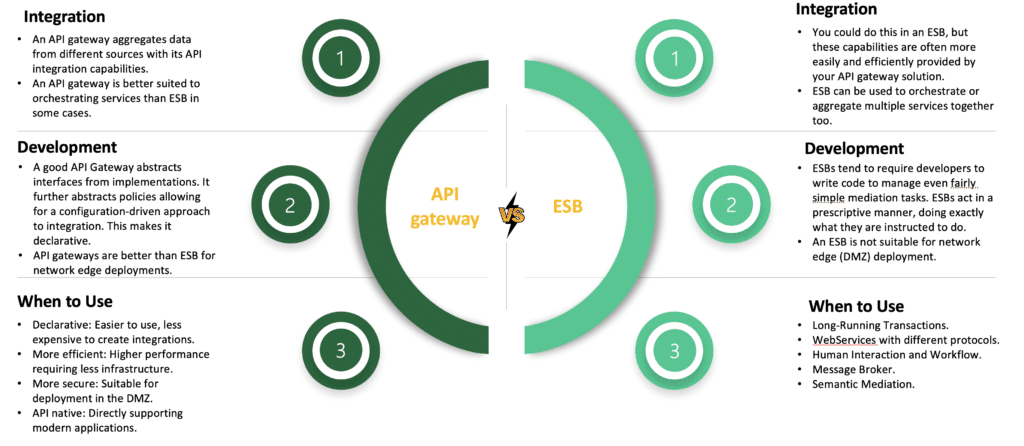
28. What is API Gateway?
An API gateway is a management tool that sits at the edge of a system between a consumer and a collection of backend services and acts as a single point of entry for a defined group of APIs. The consumer can be an end-user application or device, such as a single page web application or a mobile app, or another internal system, or third-party application or system. Below diagram shows how an API gateway often sits between the public internet and the demilitarized zone (DMZ) of a private network.
29. What is the use of Middleware(App Glue) In Enterprise Context?
Here are 6 Fundamental Principles for Middleware in Enterprise Context:
- Transnationality
- Event handling
- Queuing and buffering
- Extract, transform, and load
- Translation and transformation
- Mediation routing
Summary
I hope this consolidated Salesforce Integration Interview question will help you to get a dream job as Salesforce Integration Architect or Integration Developer in Salesforce. Check our Salesforce Developer Interview question and answers post as well.

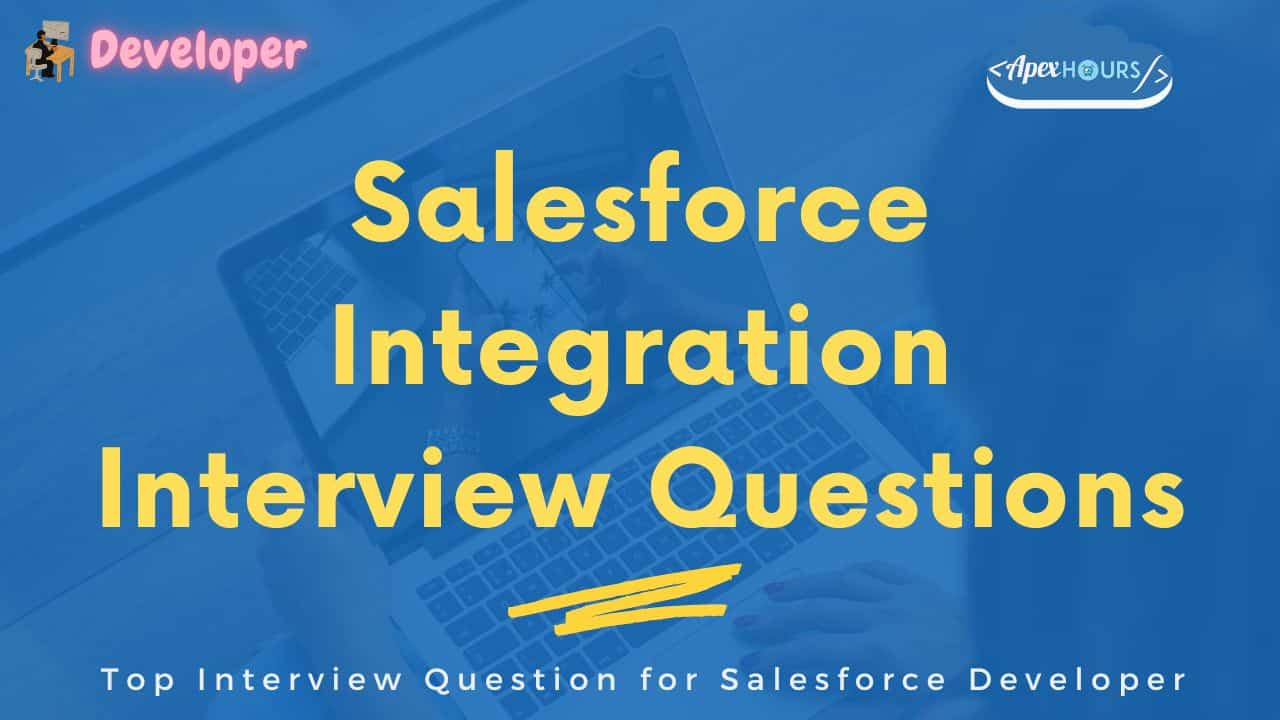

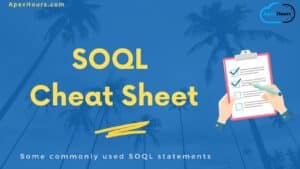
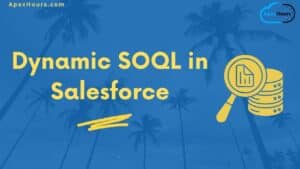
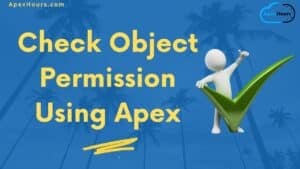
Hi Amit! Great article! You have a typo, I think. We usally refer to Web Service flow as “Web Server” flow.
you are right I will fix it
Hats off, never seen such a clear content at one place
Glad you like it
True
Glad you like it
Hey Amit, the content is great. Could you please tell me if this question is suitable for experienced candidates?